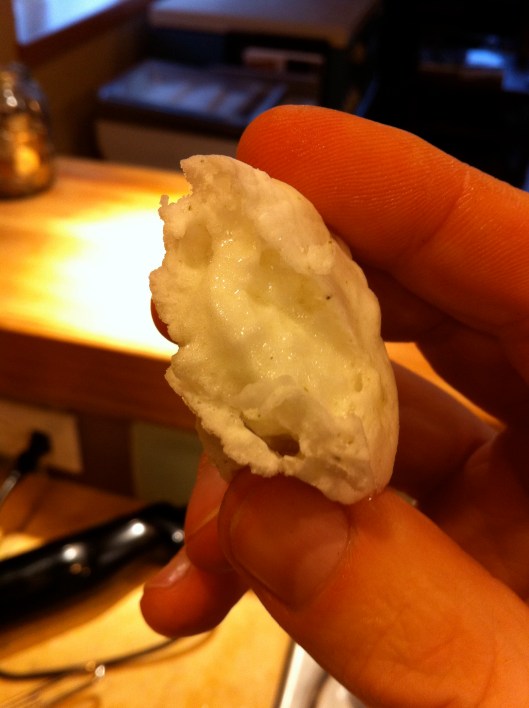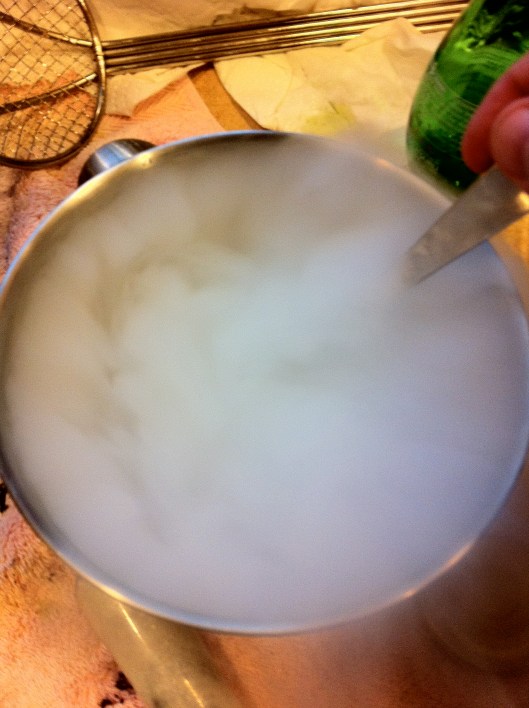Tags
Continuing my free fall into contemporary cooking techniques, I wanted to work with liquid nitrogen for some seriously cold cooking. Liquid nitrogen is incredibly cold: −321 °F/−196 °C! As it warms up, it boils away back into a gas, creating the exact opposite of a deep fryer – a deep freezer. This is the stuff that urban legend says poor Walt Disney is frozen in for possible future reanimation. My interests, however, are purely culinary.
Grabbing A Cold One
I wouldn’t be able to go to Sur la Table to get what I needed for this round of cooking. I instead went to my local provider of industrial gases and inquired about purchasing a small amount of liquid nitrogen (also known as LN). They said I couldn’t do it without the use of a dewar, a container especially designed for carrying and storing LN. So, I did some research online, waited patiently, and was able to score a small 5 liter dewar for 40% off list price on eBay.
I first read Cooking Issues’ excellent Liquid Nitrogen Primer before I got started. The three main takeaways:
- Do not keep LN under pressure in a closed container. It will explode. It can blow your hands off. Thus, a proper dewar is necessary.
- You can suffocate on nitrogen and die and you won’t even know it. Your body won’t warn you ahead of time. You must be in a well ventilated area.
- It is really, really cold. Avoid getting burned the same way you’d avoid hot oil.
It was a cold wet day in Seattle when I went to fill my dewar up with LN, but I still drove home with the windows down, the dewar tightly strapped in the back seat surrounded by towels, determined to not get killed before I froze some foodstuffs at home for my amusement. I made it back safely and got down to some cold cooking.
Deep Freeze Frying
I placed a towel on my kitchen counter and placed a metal bowl inside of a larger metal bowl on top. This was in case the LN was so cold the first bowl cracked open. At least I would have a chance to get the thing outside if need be. The window above the counter was opened for ventilation. I decided to do a bunch of different things, some successful, others less so. But it gave me a good insight into what’s possible.
First off was ice cream. I was trying to make some ice cream bowls as Ferran Adria’s video showed in his talk at Google. At elBulli, they freeze an ice cream base on the underside of a ladle and then slip it off, creating a beautiful ice cream bowl to be filled with other goodies. I, however, couldn’t get the bowls off correctly from the ladle – they were frozen solid on there, and they would always chip and break. As my LN quickly evaporated, I decided to forgo that experiment after several tries and keep trying other techniques.
I scooped up some ice cream and threw it in. It created a delicious little fudgesicle nugget, frozen on the outside but still creamy inside.
Next up was an idea for a frozen spruce meringue. I beat some egg whites and sugar together until they were fluffy, and then added some spruce spice I made last week. It turned out great – cold, crunchy, and creamy. And forest-y.
Next up – orange slices. After a quick freeze, I smashed them in a bowl to create an orange risotto.
Finally, I messed with some alcohol. Alcohol doesn’t freeze in the freezer, but LN has no problem with it. I took plum wine and poured it into a small bowl. I then stirred in LN to create an Asian alcohol sorbet.
For the most part, my initial foray into the world of liquid nitrogen cooking was very successful. And addictive. With instant fudgesicles, ice creams and sorbets, I can see it being a big hit during summer BBQs. I know now someday when I get a new home, my kitchen will have a hot station, a cold station, and a very, very cold station.
Jethro











So cool! heh.
very nice. I’ve been trying to find someplace local to get some. I figured I needed a dewar so thanks for the tips 🙂
No problem! Praxair up in Fremont sells it. They’re open Mon-Fri 9-5. Good luck!
Pingback: The Fat Duck At Home: Nitro Poached Green Tea and Lime Mousse | Jet City Gastrophysics
How much volume would you say you used to play around with? Was a 5L dewar necessary? I have access to a 1L dewar but would that even be enough to have fun with?
(I know this is an old post but I’m looking to have a Valentine’s LN Dessert night)
Depends on what you’re thinking of making, but usually I find 5L is too much for just me alone.